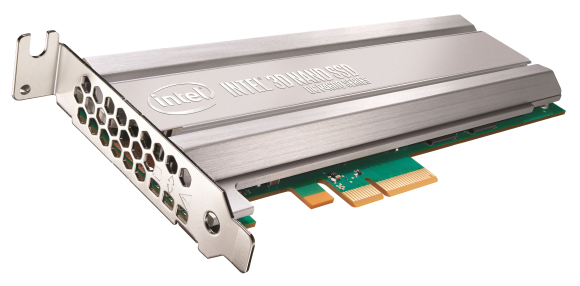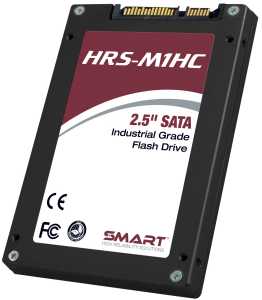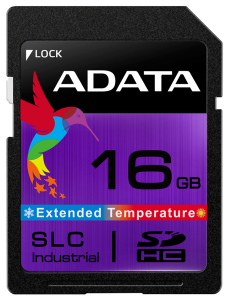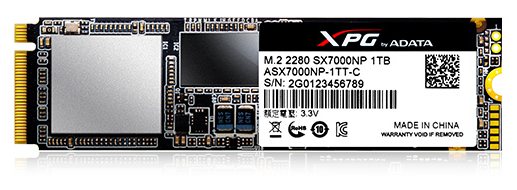- Details
- Flash Memory
Today, Intel announced two new Intel 3D NAND solid state drives for data centers, the Intel SSD DC P4500 Series and Intel SSD DC P4600 Series, along with reinforcing its commitment to expanding 3D NAND supply.

The latest additions to the Intel SSD Family for Data Center have been designed from the ground up for cloud storage solutions, including software defined storage and converged infrastructure. The Intel SSD DC P4500 Series, optimized for reads, enables data centers to get more value out of servers and store more data. Designed for mixed workloads, the Intel SSD DC P4600 Series accelerates caching and enables more workloads per server.
Add a comment- Details
- Flash Memory
![]() SP/Silicon Power, a leading provider of memory storage solutions, unveils its latest addition to its dual USB flash drive portfolio – the Mobile C31. The C31 features dual-interface design with USB Type-A and Type-C connectors that enables hassle-free data transmission between “traditional” USB laptops or PCs and new-generation Type-C devices. It also lets users instantly free up to 128GB valuable storage on any Type-C ready smartphone or tablet. For data sharing and storage expansion with ease and style instead of cables or network constraints.
SP/Silicon Power, a leading provider of memory storage solutions, unveils its latest addition to its dual USB flash drive portfolio – the Mobile C31. The C31 features dual-interface design with USB Type-A and Type-C connectors that enables hassle-free data transmission between “traditional” USB laptops or PCs and new-generation Type-C devices. It also lets users instantly free up to 128GB valuable storage on any Type-C ready smartphone or tablet. For data sharing and storage expansion with ease and style instead of cables or network constraints.
The drive’s 360° swivel cap never gets lost and always protects the end that is not in use. And it is made with a classy diamond cut pattern that adds a lot of style to the swivel. The COB (Chip on Board) technology keeps the C31 tiny and compact as well as protected against water, vibration, and dust. Like a diamond it is made to last and comes with lifetime warranty.
Add a comment- Details
- Flash Memory
 SMART High Reliability Solutions LLC ("SMART HRS"), a provider of current and next-generation solid-state storage solutions specializing in ruggedized, high-performance and high-capacity solid-state drives ("SSDs") for defense, aerospace and industrial markets, today announced its new 8TB HRS-M1HC 2.5" SATA 6Gb/s SSD. The HRS-M1HC is the latest in a growing product portfolio of highly ruggedized, reliable and secure SSDs from SMART HRS. The M1HC is designed for land, air and sea applications where collecting and storing large amounts of mission critical information is essential.
SMART High Reliability Solutions LLC ("SMART HRS"), a provider of current and next-generation solid-state storage solutions specializing in ruggedized, high-performance and high-capacity solid-state drives ("SSDs") for defense, aerospace and industrial markets, today announced its new 8TB HRS-M1HC 2.5" SATA 6Gb/s SSD. The HRS-M1HC is the latest in a growing product portfolio of highly ruggedized, reliable and secure SSDs from SMART HRS. The M1HC is designed for land, air and sea applications where collecting and storing large amounts of mission critical information is essential.
SMART's new HRS-M1HC builds on its predecessor the HRS-M1, leveraging all of the ruggedness and performance features of the M-Series product line, and is available in capacities of 1, 2, 4 and 8 Terabytes. The 8TB drive comes in a high-strength industrial design 9.5 mm enclosure while the 1, 2 and 4TB drives are housed in the same but a more compact 7.0 mm enclosure that addresses the size, weight and density requirements of more standardized applications. It's fast sequential read speed of 520GB/s and write speed of 500MB/s makes it a perfect candidate for many demanding defense, industrial automation, transportation, medical and telecommunication applications.
Add a comment- Details
- Flash Memory
 ADATA Technology, a leading manufacturer of high performance DRAM modules and NAND Flash products, today launched industrial-grade ISDD361 SD cards. The cards employ meticulously-sorted and tested SLC NAND flash, and feature a hardened design optimized for extreme cold, heat, shock, and vibration. ISDD361 cards are meant for deployment in manufacturing, professional camcorder use, travel, photography, and military applications. They deliver up to 90MB/s read and are available in capacities ranging from 256MB to 16GB.
ADATA Technology, a leading manufacturer of high performance DRAM modules and NAND Flash products, today launched industrial-grade ISDD361 SD cards. The cards employ meticulously-sorted and tested SLC NAND flash, and feature a hardened design optimized for extreme cold, heat, shock, and vibration. ISDD361 cards are meant for deployment in manufacturing, professional camcorder use, travel, photography, and military applications. They deliver up to 90MB/s read and are available in capacities ranging from 256MB to 16GB.
Durable, quality-assured SLC Flash
ADATA uses only the best single-level cell Flash on industrial-grade SD cards. ISDD361 models employ SLC, which surpasses MLC and TLC (multi-level cell and triple-level cell) NAND flash in durability, longevity, and reliability. With ADATA A+ Testing methodology in place, users get SD cards with guaranteed quality, backed by a 3-year warranty.
Built rugged for extreme environments, made smart to guard data
ISDD361 cards can handle a -40°C to 85°C temperature range. For shock resistance, they are rated up to 1500G/0.5ms, while vibration tolerance extends to 20G. At the same time, the cards are more than rugged, they are also sophisticated. Products support S.M.A.R.T. diagnostics, wear leveling to prevent unbalanced cell wear, and error correction code.
- Details
- Flash Memory
![]() Sometimes bigger is better, especially when it comes to storage space. That is why SP/ Silicon Power, a leading provider of memory storage solutions, has added higher capacity memory cards with up to 256GB to its Superior Pro SDHC/SDXC UHS-I (U3) and Elite microSDHC/microSDXC UHS-I series. The latter one is for the mobile photo and video “junkies” among us. With 256GB extra storage, it’s the perfect companion for Android smartphones and tablets, as it keeps them well equipped for storage devouring high-quality photo shooting or video recording on the go.
Sometimes bigger is better, especially when it comes to storage space. That is why SP/ Silicon Power, a leading provider of memory storage solutions, has added higher capacity memory cards with up to 256GB to its Superior Pro SDHC/SDXC UHS-I (U3) and Elite microSDHC/microSDXC UHS-I series. The latter one is for the mobile photo and video “junkies” among us. With 256GB extra storage, it’s the perfect companion for Android smartphones and tablets, as it keeps them well equipped for storage devouring high-quality photo shooting or video recording on the go.
The Superior Pro SDXC UHS-I (U3) is indispensable for high-performance video and photography use and its 256GB capacity caters for the particularly high demand in storage space for 4K high-resolution Ultra HD video recording. UHS Speed Class 3 (U3) ensures smooth performance for the capture of excellent image quality.
Add a comment- Details
- Flash Memory
SK Hynix Inc. today introduced the industry's first 72-Layer 256Gb (Gigabit) 3D (Three-Dimensional) NAND Flash based on its TLC (Triple-Level Cell) arrays and own technologies. The company stacks 1.5 times more cells for the 72-Layer 3D NAND than it does for the 48-Layer 3D which is already in mass production. A single 256Gb NAND Flash chip can represent 32GB(Gigabytes) storage.

SK Hynix launched 36-Layer 128Gb 3D NAND chips in April 2016, and has been mass producing 48-Layer 256Gb 3D NAND chips since November 2016. In just 5 months, the company has developed the 72-Layer 256Gb 3D NAND chips, securing the industry's finest product portfolio.
Add a comment- Details
- Flash Memory
 In a world where the meaning of big is constantly redefined by small, ASMini, the latest pocket-sized invention from digital storage leader Apacer, is certainly one step ahead. Featuring an admirable sustained read/write speed of 450MB/s and 400MB/s, this name card sized SSD offers a respectable capacity of 240GB(MAX) in storage. Engineered to resist shock and impact, your data will not only be safely guarded, but they can also be accessed when on a go without concerns over damage.
In a world where the meaning of big is constantly redefined by small, ASMini, the latest pocket-sized invention from digital storage leader Apacer, is certainly one step ahead. Featuring an admirable sustained read/write speed of 450MB/s and 400MB/s, this name card sized SSD offers a respectable capacity of 240GB(MAX) in storage. Engineered to resist shock and impact, your data will not only be safely guarded, but they can also be accessed when on a go without concerns over damage.
The outcry for a light, compact memory storage that has the portability of a thumb drive and the capacity of a hard drive has finally been answered! ASMini is an accomplishment of Apacer’s renowned expertise in mobile storage and techniques in building superb SSDs, or even better, it is anti-shock and comes with an ultra-fast speed, making it a must for professionals working around high mobility.
Have it All in Your Pocket, Literally
At the size of a name card with 8.1 cm x 5.4 cm in dimension, ASMini has unequalled portability with only 0.6cm in thickness. It is designed to fit inside any pocket, delivering huge performance in a small package. With up to 240GB in memory capacity, ASMini can hold up to 6 hours of 4K video and truly satisfy those who have storage demands.
- Details
- Flash Memory
ADATA Technology, a leading manufacturer of high performance DRAM modules and NAND Flash products, today launched the SX7000 SSD as part of its growing XPG gaming brand. The SX7000 uses an M.2 2280 form factor and carefully-sorted 3D TLC NAND Flash, paired with an SMI controller. The SX7000 interfaces with motherboards via PCI Express 3.0 x4 and meets NVMe 1.2 specifications to deliver 1800MB/s read, 850MB/s write, and 130K/140K IOPS. The SX7000 is available in 128GB, 256GB, 512GB, and 1TB, making the most of the flexibility of 3D NAND to present consumers with greater choice based on budget and need.

Extra-fast PCIe3x4 M.2 for a wider audience
The SX7000 connects to desktop and notebook PCs via low profile M.2 2280 and channels data through four-lane PCI Express 3.0. It uses 3D TLC NAND, meticulously sorted to ADATA standards, making the SX7000 a more accessible first-time M.2 purchase for many users. With NVMe 1.2, the SX7000 represents a massive upgrade compared to SATA SSDs and hard drives. Read speeds go up to 1800MB/s while write performance reaches 850MB/s. Those equal roughly ten times HDD performance, and compare very favorably with the 500MB/s read/write of SATA SSDs. Read and write IOPS figures are also at least 40% higher than SATA SSDs. The SX7000 is ideal as a fast boot/OS drive for first time buyers, cutting down boot delays to a few seconds. As a storage drive it offers significantly lower loading times in games and other applications.
Add a comment- Details
- Flash Memory
 To meet the ever growing demands of the embedded and industrial storage market, Innodisk is launching the SATA 3IE4 series with integrated Marvell controllers. Running on Innodisk’s proprietary iSLC technology, it provides performance equal to that of SLC at a much lower cost. The iSLC technology in combination with integrated LDPC error correcting code ensures an extended lifespan; upward to seven times that of standard MLC products.
To meet the ever growing demands of the embedded and industrial storage market, Innodisk is launching the SATA 3IE4 series with integrated Marvell controllers. Running on Innodisk’s proprietary iSLC technology, it provides performance equal to that of SLC at a much lower cost. The iSLC technology in combination with integrated LDPC error correcting code ensures an extended lifespan; upward to seven times that of standard MLC products.
Traditional MLC flash boasts high capacity, but often falls short with regards to product lifespan. SLC is a better choice for performance and longevity; however the cost is comparatively high. This is where iSLC comes in as a golden mean with a drastic increase in lifespan compared to MLC products, while sporting SLC like performance at a much lower price. This makes iSLC SSDs the perfect choice for industrial and embedded applications where MLC often do not meet longevity demands and SLC are seen as too costly.
The in-house designed technology behind iSLC is simple, but ingenious. MLC cells which typically hold two bits are made to hold just one instead – effectively emulating SLC cells. With this is place, not only is lifespan increased, but write speed reaches SLC levels.
Add a comment- Details
- Flash Memory
Western Digital Corporation, a global storage technology and solutions leader, today introduced its fastest WD brand portable drive yet, the My Passport SSD. Featuring blazing-fast speeds and award-winning design, the new My Passport SSD compliments the company's leading portfolio of My Passport palm-sized storage devices. Designed for content creators and tech enthusiasts, the new My Passport SSD combines exceptional speed and portability to manage massive files on the go.

"The WD brand is focused on delivering fresh, new personal storage devices that offer amazing performance in a beautiful, yet durable design," said Sven Rathjen, vice president of marketing, Client Solutions, Western Digital. "Our fastest portable drive yet, the My Passport SSD is a powerful solution for people who need to move content quickly and easily wherever life takes them."
Add a comment
